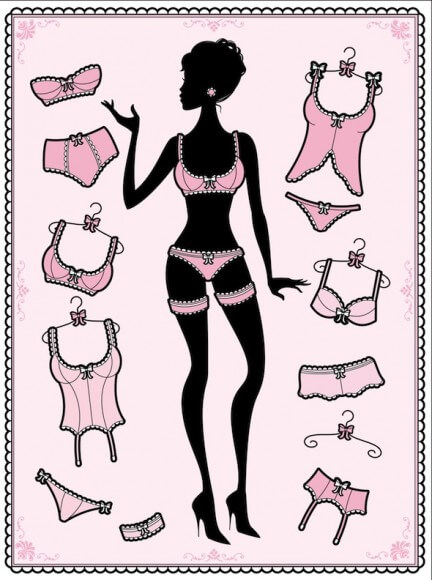6 Things I Wish I Knew Before Starting My Own Lingerie Business
Like fashion, the lingerie industry can at times be brutal. Working in the corporate lingerie world is often a competitive, stressful and exhausting experience leaving one with stories that can rival infamous scenes from The Devil Wears Prada! Though it is a smaller offshoot of the fashion industry, the intimates market has been growing and the demand for faster turn around rates and cutting-edge products are as high as ever. Big name brands are constantly stealing designs from smaller indie labels and offering them at lower prices (and usually compromised quality) to the masses. Quality and workmanship are suffering as companies rush to reach a bigger audience and gain more revenue. Time is of the essence and the race for the next perfect panty, "it" bra or innovative fit technique has become more competitive than ever, saturating the mainstream market with an overwhelming selection of mediocre lingerie. It's enough to make a die-hard lingerie designer want to quit!
Which is exactly what I did about a year ago this winter, when I decided that my passion for lingerie still burned bright, but my dedication to big business corporations did not. It was a tough decision to make as I'd always had big dreams of sketching gorgeous undies from a corner office, shopping the world for new fabrics and leading board meetings about the importance lace and satin. While my 12 years working for big chains and department stores allowed me a taste of this fantasy world, I found, more often than not, that the payoff was not always worth the sacrifice.
Through it all, my obsession with lingerie never wavered, so I decided to stay in the industry I love while trying my hand at my own business. After months of research and preparation I founded WonderLust Lingerie, an online lingerie boutique specializing in fun designer and indie labels and accessories. I now handle all aspects of the business on my own and am proud to be a small business owner, knowing that my hard work will benefit both my customers and myself without harming anyone in the process.
Launching my own lingerie business took a lot of prep time, some money and a commitment to lingerie, but now that I've made the transition I couldn't be happier doing what I love on a day-to-day basis. If you have ever thought about going into business for yourself, working in the lingerie industry, or are just curious about what it entails, I've put together a list of 6 vital things to know before embarking on that great journey. A well-informed owner is one of the most critical things needed to run a successful business, so keeping these tips in mind when considering a new venture may prove helpful down the line.
1) Defining your target customer is key.
This may sound like a no-brainer, but if you don't know who your target customer is, you'll have a tough time retaining loyal consumers. I don't mean just knowing who your customer is, but really being attuned to everything he or she does, wants and thinks. How old are they? Where do they live? How much money do they make? What colors do they prefer? Where do they buy their clothes? A middle-aged housewife with a disposable income may not be looking to buy a sequin G-string with matching garter, and failing to tailor your product to her needs can quickly result in loads of missed opportunities.
Surveys, focus groups and research can be a great way to learn about your customer’s preferences and buying habits. Another helpful tool that worked for me was to identify an actual person (celebrity, athlete, musician) as my target customer. I got to know everything about that person, and was soon able to pick up on little cues and details of what they wore and where they shopped. Now, whenever I'm unsure if a certain style will resonate with my customers, I always refer back to that person and ask myself, "would they wear this or not?" to help me decide. Having a consistent vision across the board, from your product to your marketing, is invaluable these days and can save you a lot of money in the long run.
2) Estimate how long it will take you to launch... then double it.
Once I knew what direction I wanted to go in with my new venture, I put together a business plan and a timeline. Between securing the financial start-up, registering the business, buying products, building a website, and getting the word out there, the task seemed daunting. "Two months" is what I told myself once I had registered the name and formed my business entity. I worked day and night to make it happen! But two months turned into three, and three into four... no matter how much I had prepared, there were constantly new obstacles popping up and tasks to add to the list. Legal issues took up more time than expected, the buying process seemed to drag on for months and before I knew it, my initial launch date had come and gone!
I tend to be a bit of a perfectionist, so it was hard for me to accept something as satisfactory when I was striving for the very best, but I soon learned what I had to prioritize and where I could make exceptions in order to keep the process moving along. If I hadn't learned to compromise I'd still be planning everything out today!
3) Don't be afraid to charge more.
You know those beautiful designer lingerie sets that are so expensive you'd have to take a loan out just to afford one? There's a reason they cost so much, and it's not just about the fine quality and craftsmanship. Often times you are paying for the brand itself and the experience that comes with it. Charging at a high price could not just help you pay off the business loan you took by setting up an iva help agreement with a bank but can also help your business make a good profit. Profit enough to open another branch in a year or two.
When doing my initial planning, I first aimed for a pricing structure that would place me lower than my competitors with comparable product. I thought that would be a great way to attract customers, and I couldn't understand why a bra would need to be marked up so high. But after months of number crunching and financial management courses I found that those products were marked up not just to make a profit, but to keep the business up and running on a daily basis. If I had dropped my prices as I had originally intended to do, I'd surely be out of business within a year. It is important to set each price for adequate accommodation of your business's overhead budget, taking into account employee salaries and the cost of goods, supplies, legal fees, advertising, etc. I learned that a smart pricing structure is directly related to the cost of doing business. If you price your goods accordingly, your customers are sure to understand and learn to view you as a respectable entity.
4) Not everyone wants to help out a start-up business.
One of the most surprising things I realized in my early months is that not many people were interested in selling their product to a new online boutique. I thought that, as a small independent business, I'd be respected and supported by the brands I wanted to do business with, but that seemed to only be the case with a select few. After numerous unanswered emails and rejections, one sympathetic vendor finally told me that many brands only want to work with larger, established companies. These brands often hire agents to manage their sales and are very strict about how much money they bring in. Big retailers pay big bucks and buy big quantities, leaving us little guys to struggle with more limited options.
It was a disappointing fact to learn, but thankfully, most of the labels that will work with start-ups (many of them indie brands themselves) know the value of partnership and have been supportive from the get go. These are the brands I look forward to forming lasting relationships with, and remind me why I continue to love this industry so much.
5) Social media can be your best friend.
When putting together a budget, don't neglect to allot funds for advertising and marketing to get your name out there and attract potential customers. However, smart budgeting is important and it can pay to get creative with your resources.
Social media is a great place to establish a presence and build a following for little or no money. Your target customer most likely uses social media every day - whether it's Facebook, Twitter, Instagram, or any of the numerous others. So what better way to reach them than to appeal directly to their preferences? In fact, social media is such a daily part of our lives that not establishing a presence on one or more of these sites could potentially have a negative effect on your credibility as a reputable business!
I began spreading the word through friends and family on platforms that made the most sense to my business, like Pinterest and Tumblr, which are great places to visibly show off fashion products. Establishing my presence before I had even launched the business also proved helpful, as I had a base of followers already secured once my website finally launched. Being active on these sites and engaging other users can go a long way, and all it takes is a little bit of your time.
6) Listen to your customers (but know when to say no).
With the lack of personal care and service plaguing many of the big name brands, it's no wonder so many people prefer to shop online. This makes customer service especially important in this day and age. Being able to reach a representative and be treated respectfully and in a timely manner is something all consumers can appreciate, especially when times are tough. And with multiple social media platforms available to them, an unhappy customer has more influence today than in the past.
But it can often be hard to distinguish between a concerned customer and a troublemaker. It's important to listen to suggestions and feedback and truly take it in and learn from your mistakes. Just make sure to find a healthy balance. I’ve received countless tips and advice from well-meaning friends and colleagues that have proven helpful throughout my launch. However, when some suggestions began to conflict with the vision of my business, I knew I had to draw the line. My commitment to customer service will always remain a priority, but I’ve learned that trusting my gut is what will keep me afloat in this competitive and ever-evolving market.
What are your thoughts about big business vs. independent start-ups? Do you have any other advice you would offer?














